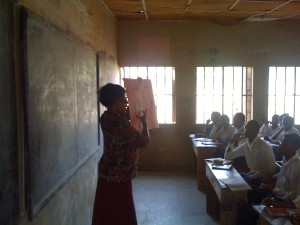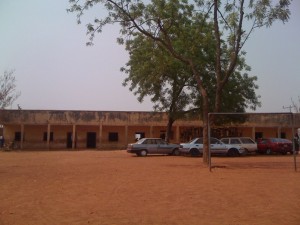A series of blog posts looking at the key themes within education. Comparing the similarities and the challenges that education faces in Nigeria and the UK.
So you think you’ve got it bad? I overheard someone in the corridor this week moaning because they had 29 students within a class. I don’t know about you but our average class size for higher sets is around 30 but is often less than that particularly lower ability ones to sometimes even around 20. What is the average class size in your school? Well imagine teaching anything from 60-80 students in one classroom, how would that impact on the learning that would take place? Would you teach differently than you do now? In fact when I was in Nigeria, one particular primary school I visited had four classrooms and around a thousand kids there so you do that maths! (See the picture of the primary classrooms below:)
When I was at GSS Karu I walked round the school and observed some lessons to see what learning was taking place. What I witnessed was a didactic, teacher led and few student interactions. The behaviour was excellent and all students seemed to be focused on their learning, popping into a science lesson learning about the kinetic theory the teacher would repeat many of the key concepts and get students as a whole class to repeat this back to him, there was also an occasional whole class question that was answered correctly in one collective voice which appeared constructed, rehearsed or perhaps it was just that they were reviewing what they already knew. With students answering the questions correctly and repeating the key concepts on the surface may sound good however how many of these students had a deeper understanding of the concepts that they were learning not just repeating the keywords that they had rehearsed?
Moving into a Maths class I saw students from as young as 11 answering questions on finding the area, radius and circumference of a circle, calculating and using Pi but without a calculator, to me this was impressive, I am not sure how many of our Year 7 students could do this. However once again it was completely teacher led, I never saw anytime that students were making sense of what they were learning, collaborating in groups, having opportunities to play an active role in their learning and developing independent learning. All these things are what we strive for at our school to ensure that we are preparing effective learners for their futures but here it didn’t happen although possibly it couldn’t happen due to there being 80 students sat in the classroom.
It made me reflect on what ‘good learning’ looks like? Which way is best? Could you get students to collaborate in groups with those numbers? Many questions were running through my mind and still are now.
Finally another important part of the learning process is feedback on how to improve, I was completely shocked to hear and see that a teacher in Nigeria will mark the student’s exercise books every day and that is a lot of books with up to 80 in a class. This feedback is much more frequent that here in the UK, could you imagine marking your classes’ books every day? I think this can only benefit the students particularly as I saw good feedback in student’s books telling the student exactly what they needed to do to improve and make progress which is exactly what all students’ need.
So what do you think about teaching in Nigeria? How does the learning that I have described here compare to what happens in your classroom?


